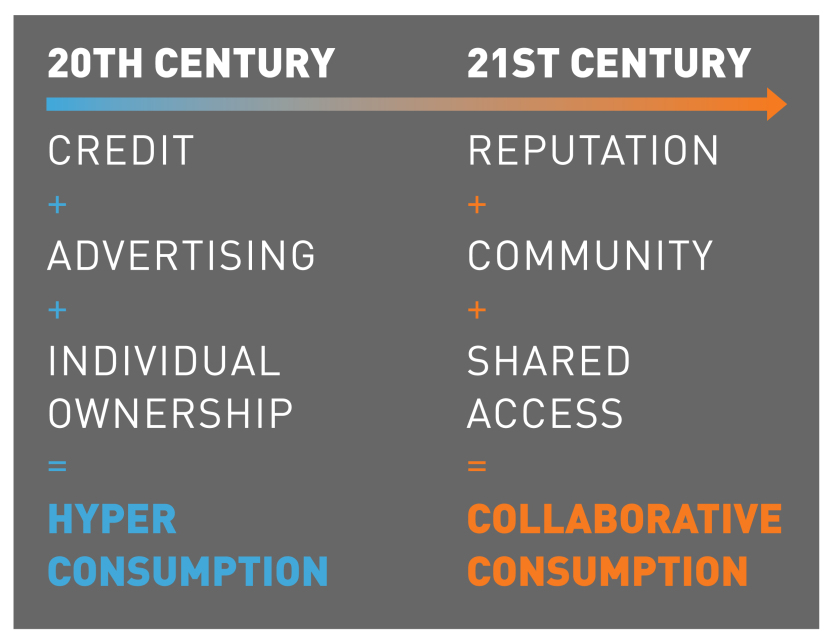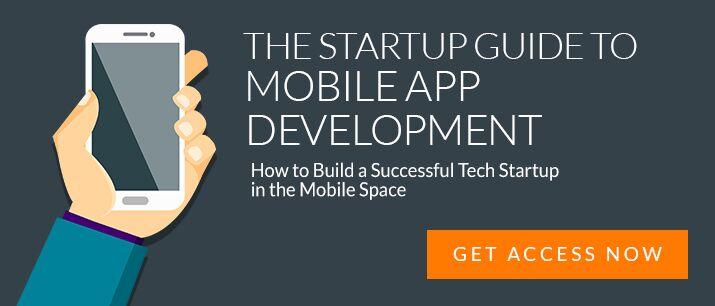5 Exciting Predictions For The Future Of Collaborative Consumption
“The way we think about supply and demand will change; the relationship between buyers and sellers will be disrupted; and the person formerly known as the “consumer” will now get what they need from each other.”– Rachael Botsman, Pioneer of collaborative consumption.
Over the past 5 years the collaborative consumption movement has gained an incredible amount of buzz.
Named by Time in 2014 as one of the “10 ideas that will change the world”, this model has totally disrupted industries that previously didn’t give much power to the consumer.
Bonus: 5 Revolutionary Tech Projects Changing The World For The Better
But what is it?

Collaborative consumption is basically traditional sharing on steroids.
Thanks to efficient networking technologies (like social media, apps, portals) it has never been easier to buy, rent, swap, sell, trade, gift, you name it…on a scale never before thought possible.
We’ve all heard of the giants of this movement: Airbnb lets you rent a room to strangers, Kickstarter lets you source and invest funds for great ideas, eBay lets you buy and sell second-hand goods and Uber lets you book a taxi on demand.
But did you know about all this other weird stuff you can do collaboratively?
- Book a parking space 6 months in advance
- Use someone’s parking permit for an hour
- Buy someone’s leftover dinner
- Have someone assemble your Ikea furniture and clean your oven
- Get legal advice
- Share your solar energy
- Get someone to hold your place in line for the new iPhone
Ok, not all of those you can do in Australia – our regulation is a LOT tighter than the US, we’ll touch on that later – but you get the idea.
Some thought that it was just a reactionary fad caused by the recession, but collaborative consumption is actually an incredibly efficient and sustainable economic model.
Why?
It makes use out of resources that were previously just sitting idle. And it lets buyers and sellers both profit.
Other benefits include:
- Minimising the environmental impact that comes with rampant consumption
- Greater convenience and access to end users
- Usually lower cost than existing professional services
So what does this mean for existing business models?
While traditional markets haven’t been completely displaced (yet), collaborative markets are growing at a rapid rate.
Revenue in the global car sharing market alone (big names include Uber and Rent A Ride) is expected to grow from US$1 billion in 2013 to more than US$6 billion in 2020.
As sharing economies become more mainstream, we can only expect other collaborative markets to expand.
Tell me what the future will look like
Looking into my crystal ball, I can see massive disruption.
And that’s pretty damn exciting.
Here are my 5 predictions for the future of collaborative consumption, and how it will evolve in the coming decade:
1. Sensory technology will join the party
Above all, the convenience that collaborative consumption provides is dependent on technology.
So, any technology that improves the foundations that this model is built on (trust, communication, reliable payment methods) will strengthen collaborative consumption.
Enter: sensor-enabled products and spaces.
GPS, sensors and data wrapped up neatly in web-based and cloud-based platforms will all improve the sharing experience.
Having access to a wider range of real-time data will let connected businesses track the whereabouts and usage of different assets.
It’s also expected that with this new wealth of data, a lot of new businesses will crop up to streamline the collaborative consumption experience.
Who’s doing it already?
Aunka Arya of Braintree envisions a connected travel experience for AirBnb, where your smartphone is constantly communicating with the environment around you.
“You can imagine a world where you walk into a place that you’re going to stay and the lights automatically dim, you walk up to the door and it automatically unlocks.”
Pretty cool, huh?
The result will look like a layering of services in any given consumption experience –collaborative businesses collaborating among themselves, so to speak.
Think of all the collaborative services you can layer on top of the foundation of travel, for example.
You book a stay on AirBnb for your next trip.
It’s time to go! You receive a notification from Uber when it’s time to drive to the airport.
You’ve arrived safely. Now you rent a car on Ride My Car so you can travel freely during your stay.
Hungry yet? You check to see if anyone is offering to host a dinner party for you in their home tonight.
And so on and on and on.
2. Luxury fashion and home electronics will be hit the hardest
The whole business case for collaborative consumption is that it maximises resources that are underutilized in existing markets.
So it shouldn’t come as much surprise that products which sit around idle for much of their short lives will receive a makeover.
Expensive products like electronics and high-end clothing are most susceptible to collaborative business models.
See also: 5 New Technologies Disrupting The Retail Industry
Did you know that the average power drill is used for 12 minutes in its lifetime, and costs upwards of $200? This was why neighborhood sharing platforms like Friends With Things were invented.
Businesses that want to survive must offer renting services and peer-to-peer secondhand sharing services to accompany their traditional product-focused business models.
Some companies are already doing this, most notably in the auto industry.
BMW Drive Now (video), Volkswagen Quicar (video) and Peugeot Mu (video) have all created their own car-sharing service that let people rent available vehicles online, via mobile apps, or through local dealers.
H&M in the US is rewarding customers with coupons for swapping old clothes, and Patagonia has teamed up with eBay to offer a redistribution market for its pre-owned clothing.
The reality is that sharing ecosystems will evolve around your business’ product or service anyway, so it’s better to partner with, invest in, or create your own peer-to-peer sharing services and take a cut!
3. Service industries won’t escape either…
The seed has been planted for B2C service industries to become more collaborative.
Platforms like Skillshare and Spoon Feed Me are already transforming education by allowing users to learn skills they would previously have to go through institutions for.
See also: How Technology Will Transform Our Broken Education System
Another industry ripe for disruption is financial services.
The key benefit of collaborative finance is it gives people access to more open systems for financing.
Bonus: What FinTech Is And Why All Businesses Should Care
Crowdfunding platforms like KickStarter and Indiegogo remove the need to go to physical branches for loans and funding, while social lending platforms embrace the shift from institutional trust to peer trust.
SocietyOne is the hot topic in fintech right now – they are pioneering peer-to-peer lending in Australia.
Peer-to-peer lending allows investors to lend a fraction of a normal loan directly to a borrower without the need for another party such as a bank – this opens up investing to everyday people all over Australia. They recently partnered with Uber to help drivers access loans to purchase cars. Layers on layers of collaborative consumption!
According to the Millenial Disruption Index, 71% of Gen Y-ers would rather go to the dentist than listen to what banks are saying.
There is far greater perceived transparency and control in collaborative models than in institutionalized banking.
Remember the famous Bill Gates quote, “Banking is necessary – banks are not“?
Yep, that’s looking pretty accurate right now.
4. Legislation will be updated
Should Uber pay GST? Should Airbnb pay hotel tax? What happens with insurance if a Relay Ride driver is killed in a traffic accident?
The answer to these questions and more in...nothing.
Our current regulatory system is woefully inadequate and incapable of addressing the collaborative consumption movement.
The Corporations Act was written in 2001, and I’m pretty sure it didn’t plan for people to let strangers use their cars.
The role for government is becoming increasingly clear as collaborative businesses gain momentum:
- Ride sharing companies in particular have faced legal action, with many being fined, sued and threatened. Uber is now finally legal in New South Wales, Victoria and Western Australia, but there’s still a lot of work to be done on safety-based legislation.
- Landlords are complaining about tenants violating the terms of their leases by allowing people to sub-let their properties.
- Tax collectors are asking whether all the income from sharing schemes is being declared, especially as it’s not uncommon now for this to be a sole source of income.
Local councils and governments need to revise legislation to enable businesses to safely adopt collaborative models without the threat of legal action.
When the automobile was invented, it had to follow the rules of the road designed for horses. This was obviously ridiculous, so new legislation was eventually rolled out.
The same will eventually happen so society can adjust to a new way of organizing economies.
5. Hospitals will save a ton of money
The healthcare industry is one of the biggest culprits of under-utilising capital.
Hospitals currently operate under the hyper consumption model, paying $300,000 or more for medical devices that are only used for a fraction of their lifetimes.
While medicine has come a long way in the last few decades, the healthcare system has not.
Cohealo is the first (and currently only) business that is reducing this waste by introducing a collaborative market to hospitals.
In a nutshell, it’s a software platform that tracks utilisation of assets.
This means that Hospital A can rent out their expensive MRI machine to Hospital B when it isn’t in active use, and both hospitals win.
The result is a model that lowers the massive inventories for hospitals previously operating as individual facilities.
The Cohealo ecosystem has over 200,000 clinical devices used in the Operating Room departments across several health systems, and is growing at a phenomenal rate.
But what about smaller-scale collaborative health initiatives?
We know that proximity to healthcare services is one of the biggest reasons why some people miss out on necessary healthcare.
in 2013, Uber piloted UberHEALTH in 3 major US cities. Since then, every Winter they have brought back the initiative and it’s now serving 35 US cities.
The initiviate is basically a healthcare delivery service where Uber users can request a free flu shot on demand.
While it hasn’t all been smooth sailing, this has laid the foundations for the health system to meet the collaborative economy.
Looking back at the success of these ventures in healthcare, you can expect to see a range of collaborative services being applied to this sector in the future.
Bonus: Why Mobile Health Tech Is So Much More Than Fitness Apps
Clearly, there is no end to the future possibilities of collaborative consumption across all industries.
It’s here to stay, so governments and businesses better get used to it.
I’d love to know what you think the future of collaborative consumption will look like! Let me know in the comments.
Got an app idea you’re ready to bring to life? Don’t miss the guide that helped a startup app sell for $12 million…
Latest posts by Logan Merrick (see all)
- Ep 18: Collective Campus’ CEO on Intrapreneurship and Corporate Innovation - December 20, 2016
- 50 User Engagement Strategies For Planning Memorable Mobile Experiences - December 19, 2016
- Latest Data: App Monetisation Trends And Drivers 2015-2020 - November 25, 2016




